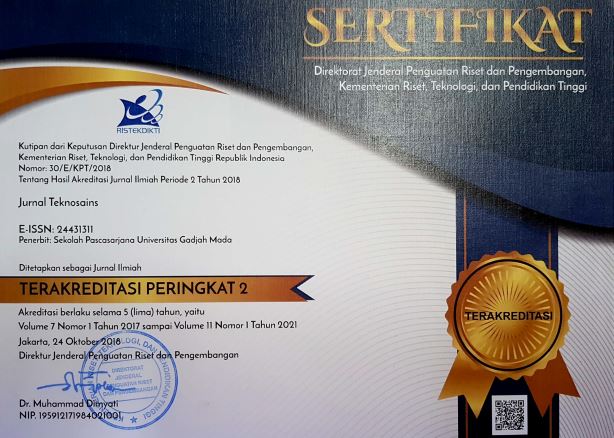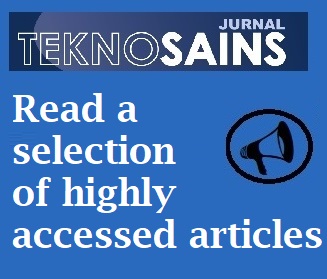Optimalisasi kapasitas energi angin dan matahari dengan konfigurasi mikrogrid berdasarkan karakteristik beban
Dhanis Woro Fittrin Selo Nur Giyatno(1*), Lukman Bagus Subekti(2), Adlan Bagus Pradana(3), Indriana Nurmawati(4), Indra Wibowo(5)
(1) Departemen Teknik Elektro dan Informatika, Sekolah Vokasi, Universitas Gadjah Mada
(2) Departemen Teknik Elektro dan Informatika, Sekolah Vokasi, Universitas Gadjah Mada
(3) Departemen Teknik Elektro dan Informatika, Sekolah Vokasi, Universitas Gadjah Mada
(4) Departemen Teknik Elektro dan Informatika, Sekolah Vokasi, Universitas Gadjah Mada
(5) Departemen Teknik Elektro dan Informatika, Sekolah Vokasi, Universitas Gadjah Mada
(*) Corresponding Author
Abstract
Diploma III Electrical Technology Study Program is a institutional vocational education institutional in Department of Electrical Engineering and Informatics that aims to produce graduate who are ready to work in operation and maintenance of power system. Since phenomena of scarcity of fossil fuels, study program meet the 2 major problems, namely the limitations of electrical energy for practical lab work and increased job skills on the electrical energy conversion of electrical energy from renewable energy. The purpose of this research is to optimalize capacity of solar and wind energy contained in the environment of the laboratory on the microgrid configuration, namely PV-Wind turbine-Battery. Software HOMER is used to simulate microgrid configuration with AC-DC load, AC load, and DC load. The results show indicate that microgrid PV-Wind turbine-Battery is more economically to meet the need AC-DC load than the others.
Keywords
Full Text:
PDFReferences
[1] D. Teknik Elektro dan Informatika, “Kurikulum D-III Teknologi Listrik,” Departemen Teknik Elektro dan Informatika - Sekolah Vokasi Universitas Gadjah Mada, 2016. .
[2] A. Zangeneh, S. Jadid, and A. R. Kian, “Promoting strategy of clean technologies in distributed generation expansion planning,” Renew. Energy, vol. 34, no. 12, pp. 2765–2773, 2009.
[3] H. A. Gabbar, R. Islam, M. U. Isham, and V. Trivedi, “Risk-based performance analysis of microgrid topology with distributed energy generation,” Int. J. Electr. Power Energy Syst., vol. 43, no. 1, pp. 1363–1375, 2012.
[4] R. Wardani, “Pemanfaatan Energi Terbarukan ‘is a must,’” Direktorat Jenderal Energi Baru Terbarukan dan Konservasi Energi (EBTKE), 2018. .
[5] M. H. Hasan, W. K. Muzammil, T. M. I. Mahlia, A. Jannifar, and I. Hasanuddin, “A review on the pattern of electricity generation and emission in Indonesia from 1987 to 2009,” Renew. Sustain. Energy Rev., vol. 16, no. 5, pp. 3206–3219, 2012.
[6] M. H. Hasan, T. M. I. Mahlia, and H. Nur, “A review on energy scenario and sustainable energy in Indonesia,” Renew. Sustain. Energy Rev., vol. 16, no. 4, pp. 2316–2328, 2012.
[7] H. Firmansyah, Y. Tan, and J. Yan, “Power and methanol production from biomass combined with solar and wind energy: analysis and comparison,” Energy Procedia, vol. 145, pp. 576–581, 2018.
[8] B. K. Sovacool, “Success and failure in the political economy of solar electrification: Lessons from World Bank Solar Home System (SHS) projects in Sri Lanka and Indonesia,” Energy Policy, vol. 123, pp. 482–493, 2018.
[9] H. Outhred and M. Retnanestri, “Insights from the Experience with Solar Photovoltaic Systems in Australia and Indonesia,” Energy Procedia, vol. 65, pp. 121–130, 2015.
[10] Y. Haroen, “Hydro, solar, and wind energy as potential electrical power plant in Indonesia - Past conditions and future prospects,” 3rd Int. Conf. Inf. Technol. Comput. Electr. Eng. ICITACEE, pp. 1–1, 2016.
[11] F. Ardin, A. Rahardjo, and C. Hudaya, “Electricity price and subsidy scenario for hybrid power generations on off-grid system,” Int. Conf. Control Electron. Renew. Energy Commun. ICCREC, pp. 132–138, 2017.
[12] Z. Ma et al., “Solutions for Remote Island Microgrids: Discussion and analysis of Indonesia’s remote island energy system,” IEEE Innov. Smart Grid Technol. - Asia ISGT Asia, pp. 493–498, 2018.
[13] A. J. Veldhuis, A. Nobre, T. Reindl, R. Ruther, and A. H. M. E. Reinders, “The influence of wind on the temperature of PV modules in tropical environments, evaluated on an hourly basis,” IEEE 39th Photovolt. Spec. Conf. PVSC, pp. 0824–0829, 2013.
[14] I. N. S. Kumara, W. G. Ariastina, I. W. Sukerayasa, and I. A. D. Giriantari, “On the potential and progress of renewable electricity generation in Bali,” 6th Int. Conf. Inf. Technol. Electr. Eng. ICITEE, pp. 1–6, 2014.
[15] B. F. Ronad and S. H. Jangamshetti, “Optimal cost analysis of wind-solar hybrid system powered AC and DC irrigation pumps using HOMER,” Int. Conf. Renew. Energy Res. Appl. ICRERA, pp. 1038–1042, 2015.
[16] I. Elsayed, I. Nassar, and F. Mostafa, “Optimization and economic evaluation of small scale hybrid solar/wind power for remote areas in Egypt,” Ninet. Int. Middle East Power Syst. Conf. MEPCON, pp. 25–30, 2017.
[17] K. K. Jagtap, G. Patil, P. K. Katti, N. N. Shinde, and V. S. Biradar, “Techno-economic feasibility study of wind-solar PV hybrid energy system in Maharashtra state, India,” IEEE Int. Conf. Power Electron. Drives Energy Syst. PEDES, pp. 1–5, 2016.
[18] S. Ghose, A. El Shahat, and R. J. Haddad, “Wind-solar hybrid power system cost analysis using HOMER for Statesboro, Georgia,” SoutheastCon 2017, pp. 1–3, 2017.
[19] N. M. Swarnkar and L. Gidwani, “Economic and financial assessment of integrated solar and wind energy system in Rajasthan, India,” Int. Conf. Comput. Power Energy Inf. Commun. ICCPEIC, pp. 471–476, 2017.
[20] Y. Zhou, M. Panteli, R. Moreno, and P. Mancarella, “System-level assessment of reliability and resilience provision from microgrids,” Appl. Energy, pp. 374–392, 2018.
Article Metrics
Refbacks
- There are currently no refbacks.
Copyright (c) 2021 Dhanis Woro Fittrin Selo Nur Giyatno

This work is licensed under a Creative Commons Attribution-ShareAlike 4.0 International License.
Copyright © 2024 Jurnal Teknosains Submit an Article Tracking Your Submission
Editorial Policies Publishing System Copyright Notice Site Map Journal History Visitor Statistics Abstracting & Indexing









